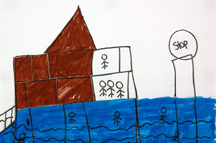Facing Life on Their Own
Alton Love, 41, rode his bicycle, back tire sagging, down a hot Baton Rouge street with his 9-year-old daughter on his handlebars, looking for the man to whom he had given his car two months before on a promise it would be fixed. He has not seen the car since.
LaTonya London, 24, was at home with four of her five children but no money, no car and no diapers.
Laura Hilton, 45, was clutching a lease for a four-bedroom home in New Orleans for $1,650 a month. Her income, in the form of government disability payments, is $1,600 a month.
These are scenes from the multiple stages of moving out and moving on. As the deadline loomed, the approximately 450 families still in the parks responded in different ways. Some finally opened the door when the FEMA workers knocked, or boarded a van hired by Sister Judith to hunt for apartments. Others broke down in tears, became entangled in delusional schemes or did nothing, passively waiting for one level of government to hand them off to another. FEMA officials said they would not forcibly remove those who
remained.
FEMA, which ultimately is a disaster-response agency, not a social service department, endured years of blistering criticism for its failure to understand that many New Orleans residents needed more than just a roof over their heads after the hurricane. The agency now is quick to admit that other agencies are better equipped to handle persistent social ills. Its job in cases like that of Ms. August, FEMA officials say, is limited to getting her housed.
Still, in its awkward fashion, the agency designed a gradual transition for residents from the parks and government care, offering an intermediate step of a 30- day hotel stay. After residents spend the first month in an apartment, the Disaster Housing Assistance Program, administered by the Department of Housing and Urban Development, would kick in, paying the full rent until March 1, 2009.
But each phase presents an opportunity for failure as well as success. What happens to those in hotels who still have not found housing at the end of 30 days? What happens to those who, come March, are in apartments too expensive to afford on their own? What about those who, for various reasons, are already ineligible for rental assistance?
At least 30 families or individuals living in Renaissance Village in its final weeks fell into the last category: Mr. Love because he could not account for the $800 FEMA gave him for rental assistance right after the storm; Ms. London because she opted to leave after her boyfriend, whose criminal record includes arrests for burglary and drug possession with intent to distribute, was banned from the park; Ms. Hilton, who can barely read, because FEMA was unable to verify her pre-storm address.
Concerns About Future
Ms. London, who eventually moved to a $900-a-monthhouse subsidized by the Homeless Alliance, acknowledged how easy it would have been to stay in the trailer park and remain dependent.
“Being in that trailer, having all that stuff, it was like we became crippled,” she said. “You had free rent; you didn’t have to worry about light bills.”
Before the storm, she said, “I was being independent. Now I feel like I’m leaning — I’m leaning.”
Ms. Hilton wanted to move her sons, George, 17, and Roy, 10, back to New Orleans because her daughter and grandchildren live there. Through the Capital Area Alliance for the Homeless, a rent subsidy could be arranged, but Sister Judith, who has focused her efforts on keeping the ineligibles off the streets, is concerned about what will happen when the subsidies expire.
“O.K., you can’t sign this lease,” she told Ms. Hilton, who stared at the ground, which was littered with beer cans. “You can’t afford this, you’re going to wind up getting evicted, then you’re going to be homeless.”
Ms. Hilton wailed, “I’m already homeless!”
Sister Judith said, “You’re going to move to a place that costs more than you get a month, does that make any sense?”
Ms. Hilton had no good answer. When Sister Judith walked away, Ms. Hilton gave a sigh. “Makes you want to drink,” she said.
Hoping for Kindness
There are some families that have been literally riven in the course of the park’s closing. Right after the storm, Joseph Griffin and his girlfriend, Sherryl Harris, lived in a trailer with Mr. Griffin’s sons, Jamal and Jermaine. The boys worked with the art therapists who came periodically to the park, and Jermaine was selected for a scholarship to Idyllwild Arts summer camp in California.
Now Jermaine, 16, has left home and school, and is staying with another family in Kenner, outside New Orleans, where he has a job at a Dairy Queen. Jamal, 13, is staying with his grandmother in Baton Rouge. Ms. Harris is getting her own place.
Mr. Griffin hopes that his boys will come back. As soon as he finds a home.
Not every case seems as difficult, however. Gloria Martin, 51, was prescribed psychiatric medication after the storm for, she said, “hearing voices.” When the medication was stolen, she began to get arrested — once for standing in the middle of the road at night, another time for getting into a fight at the food stamp office. She lost her FEMA eligibility when she went to prison.
But Sister Judith’s team found her a place at Connections for Life, a yearlong program in Baton Rouge for female ex-offenders. On move-in day, Ms. Martin moved like a person in shock. One week later, she was radiant, cheerfully working at the Connections for Life thrift store, where she helped a one-eyed man find window shades.
“I had never had nothing like this happen to me before,” she said. “A free apartment and a job, free clothes and shoes, and eating good. And sleeping good.” |



